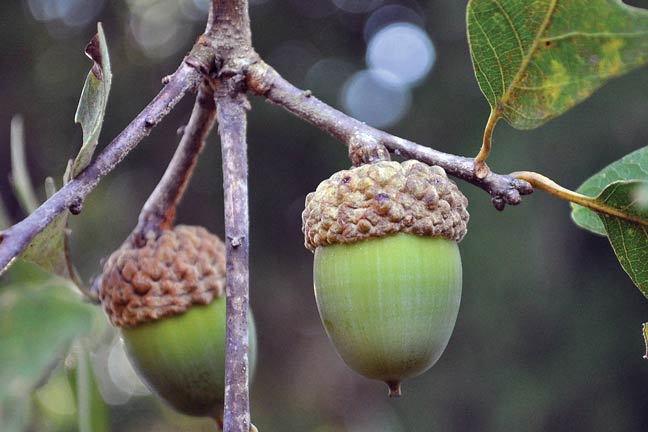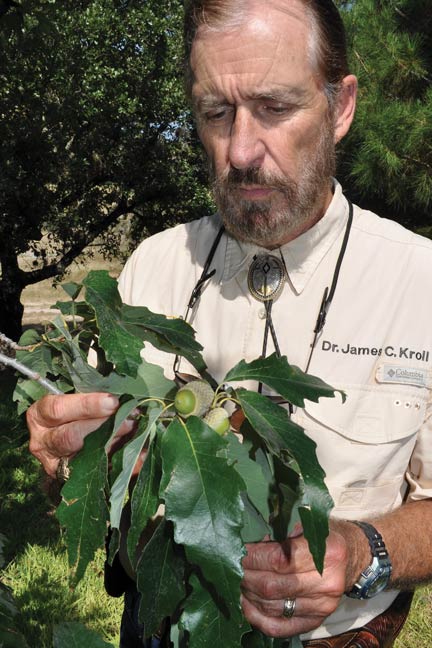November 02, 2016
By Dr. James C. Kroll
As I watched my friend Rob Hughes plant one of our food plots recently, I knew oats and clover soon would turn the dark-brown sod into a green carpet of deer food.

A person who plants a food plot is making life better for his deer for months to come, I recall thinking at the time. Then another thought popped into my head: But the man who plants an oak will make life better for his grandson's deer.
The question I'm most often asked in late summer is, "What will the acorn crop be?" I learned long ago that production varies from one property to another, due to a host of factors, so I generally just reply, "Spotty." It's hard to be wrong with that! Fortunately, there are ways to make the mast crop in your area more reliable.
Advertisement
UNDERSTANDING MAST
Mast is the fruits of trees, shrubs and woody vines. It can be "soft," such as grapes and persimmons, or "hard," such as acorns and chestnuts. And it isn't just available in fall; in a well-managed deer woods, fruits and nuts are produced over much of the year.
For instance, in some Southern woods a full year might have blackberries giving way to mulberries, then blueberries, grapes with differing maturity dates, crabapples, pears, persimmons, chestnuts and finally oaks.
Advertisement
Soft fruits have a relatively short life, as the valuable nutrient-rich tissues around the seeds decay within days. Deer instinctively know this and quickly search out (if they don't already know) the places where these trees and shrubs are abundant.
Acorns and chestnuts, on the other hand, are covered by a hard shell designed to protect the embryo from desiccation until the right moment for germination arrives. Thus, some acorns can remain sound in the forest litter for many months.
I often hear hunters say they can't wait until the acorns "sour," so the deer will come to their food plots. Rarely do acorns sour; that only happens when the shell is broken in some manner.
Barring insect infestation, an acorn in moist leaf litter is really just being stratified for proper germination. In a good acorn year, deer can find some sound fruit way into spring.
Of course, there always are exceptions. In the South, one of these is the live oak. I often see live oak acorns begin to sprout while still on the tree! When they fall to the ground, they send a root down into the litter and begin growth immediately.
NUTRITIONAL BENEFITS
At our Institute for White-tailed Deer Management & Research we've studied deer nutrition for almost five decades.
And in every study we've performed, the ranking of the most important nutritional items has been: (1) digestible energy; (2) phosphorus; and (3) protein. Yet when folks talk about improving deer nutrition, they seem to fixate on protein.
Deer are on what is essentially a "reverse Adkins diet." They can't handle foods with high fat content but thrive on those rich in carbohydrates of varying digestibility. If we analyze a white oak acorn, it's about one-half carbohydrates, one-third water, 4-5 percent fat, 4 percent protein and 4 percent fiber.
The lack of fiber makes it highly digestible. But note the low fat content: interesting in light of the fact many hunters believe acorns are rich in fat. A chestnut contains about 14 percent protein, 2 percent fat and 9 percent carbohydrate. It's also rich in phosphorus and other minerals.
Phosphorus is critical to everything from protein synthesis to energy storage in the body and DNA. Unfortunately, phosphorus is limited in most geographic areas we've studied.
Research has shown that available soil phosphorus can be significantly linked to body and antler size, so any food item rich in phosphorus is important to deer. Mast can help in this regard.
VARYING DEPENDENCE
Despite what was just noted, not all deer herds are heavily dependent on acorns. It's rare, for example, to see an oak in South Texas — yet that region produces some of the largest antlers of anywhere in the southern U.S.
In the Piedmont of Georgia, deer populations are considered to be "mast driven." That is, in years with heavy acorn crops, we tend to see higher fawn survival and growth. The soils in this region are notorious for being low in nutrients.
In most geographic areas, mast production is important in providing energy during the growing season and for fat production in late summer to early fall.
That said, the mast crop is even more important in the North, where deer often have to depend on stored fat to survive the winter. Fat storage can be tied to over-winter fawn survival and post-rut mortality of bucks.
The bottom line in this discussion is that mast is important to whitetail health and antler quality — though in some areas more than others — and managing for reliable mast production should be a critical component of any management program.
MANAGING FOR MAST
In my experience, there are three ways to increase mast production on a property. The first is to manipulate the native forest to maximize production. The second is to plant mast-producing trees in association with food plots. The third is to develop what we've come to refer to as "deer orchards."

Unfortunately, a lot of the habitat people now are managing for deer is either abandoned agricultural land that was marginal in productivity or former timber company land that was managed for commercial timber in monoculture stands.
In the first instance, the landowner is faced with "building" a forest that contains a diversity of mast producers to ensure a sustained yield of fruits and nuts. The second situation is challenging because what you're starting with is a cutover forest.
In either case, the first step is to determine the species present and the abundance of each. (If need be, consult a professional forester.) Should you find you lack mast producers, you'll have to plant them.
If, on the other hand, there are sufficient young trees of the right species present, you'll need to manipulate the stand by removing unwanted species.
The first approach is costly and takes time; you need at least 25 years to develop an oak stand that will produce reasonable amounts of acorns. In the second case, depending on the current age of your forest, you should be able to achieve peak mast production more quickly.
When starting to manage land that already has a fairly productive forest, more often than not there's still a need to improve composition in favor of mast species. Our time-tested solution to achieving this goal, both for cutover land and existing forests, is what we refer to as "Wildlife Stand Improvement (WSI)." The basic idea of WSI is to remove trees that don't produce beneficial mast (sweetgum, elm, poplar, etc.).
This can be done either mechanically or chemically. We prefer the latter, as it's much more cost-effective to use herbicides. The media has spent decades convincing you all herbicides are bad (mostly based on the use of Agent Orange in Vietnam), but in truth, most modern herbicides are quite safe. We wildlife biologists use them heavily.
Having a diversity of oaks is important. Those in the red oak family flower one year and set fruit the next; white oaks flower and fruit the same year. By growing some of each, you guard against full mast failure caused by a late killing frost. Developing a stand with a diversity of species and fruiting types helps you ensure reliable acorn production.
Some properties either don't have mast-producing species or, in the case of leased land, the landowner doesn't allow tree removal.
So you're left with two options. First, consider plant mast-producing species next to every food plot. There are many to choose from, but our research has shown the following are the only species to consider:
* fast-maturing oaks, such as sawtooth and live oaks
* chestnuts
* pears and apples
* persimmons
In our recent research, we've discovered Shumard and chinkapin oaks are excellent candidates. Properly planted, these species will begin acorn production at 10-12 years. So will live oaks.
Of course, these species won't work everywhere, so before planting, check the USDA planting zones to get an idea if they'll survive. Normally, south of the northern half of the Great Lake region is suitable for growing some type of oak.
Plant at least two specimens of each species at each plot. Be sure to plant them properly, with a protective guard against deer browsing and buck rubbing, and at a time of the year recommended for your area. In the South, my planting of choice includes sawtooth oaks, chestnuts, persimmons and pears.
We've worked with Dunstan chestnuts for some time and find them perfect candidates for whitetail mast, provided you don't plant where their "feet are wet" or beyond the historical range of chestnuts. (They can't tolerate high-pH soils.)
Our institute also has worked with Dunstan to develop a new variety of pear that holds its fruit way into the cold season and is very productive and reliable. Recent developments in native and Japanese persimmons also are extremely encouraging in latitudes from Illinois southward.
In the North, your choices are more limited. However, Shumard oak extends into parts of Illinois, Indiana and Missouri. Pears grow well in the northern states. Japanese persimmon is useful to USDA Zone 7 (-18 degrees F.).
And apples such as McIntosh will work in the far North. I don't really like to plant crabapples, as I've not seen them produce at the level desired for deer.
The last option is a strategy we've developed and tested throughout the range of the whitetail. We plant "deer orchards" of about one acre in size for every 80 acres of land. In these we plant as great a variety of species as is feasible at a spacing of 25x25 feet.
We control weed competition by mowing or spraying to enhance tree growth. Each tree must be protected from browsing and rubbing, using a 5-foot-high cage made of three 12-inch-wide pieces of livestock utility panel. Form these into a triangle by attaching the pieces with zip ties or wire, then securing to a T-post.
Whether for food plot tree plantings or deer orchards, fertilize each tree each fall with one pound of balanced (12-12-12) fertilizer per inch of basal diameter, scattered around the drip line.
Never allow herbicides such as RoundUp to touch the base of young trees, as the bark is actively growing. You can get plastic protective tubes from horticultural supply houses.
IN CONCLUSION
Mast is of great benefit to a whitetail herd. Properly managed, it can give your deer a boost throughout much of the year and improve hunting. If you can grow enough of the right mast, you'll take a long step toward better fawn survival and maximizing the potential of your bucks.
